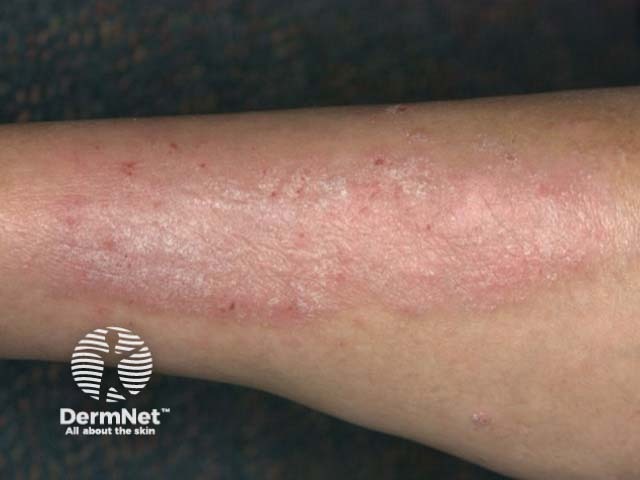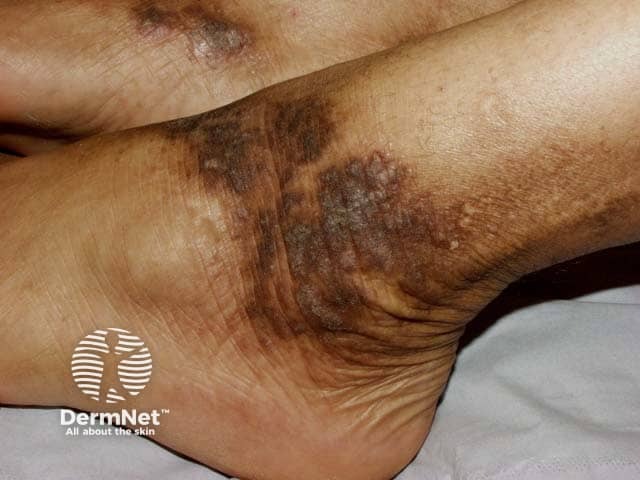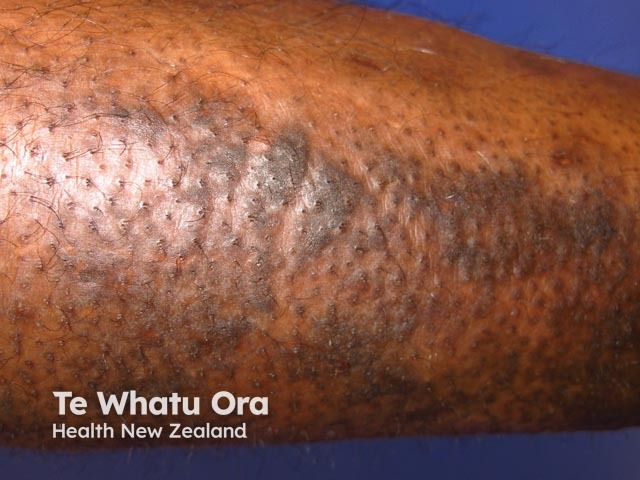Main menu
Common skin conditions

NEWS
Join DermNet PRO
Read more
Quick links
Author: Patrick Ireland, College of Health, Medicine and Wellbeing, University of Newcastle, Newcastle, NSW, Australia. Copy edited by Gus Mitchell. February 2022
Introduction
Demographics
Causes
Clinical features
Variation in skin types
Complications
Diagnosis
Differential diagnoses
Treatment
Outcome
Lichen simplex is a chronic itchy skin disorder characterised by well demarcated, erythematous patches, and plaques of thickened leathery skin.
Erythema may be variable, and lesions may be solitary or multiple. Lichen simplex is also known as neurodermatitis, lichen simplex chronicus, and neurodermatitis circumscripta.

Localised lichen simplex on the lateral shin - a common area for this disorder

Lichen simplex on the ankles - accentuated skin markings, scale and pigmentation in skin of colour

Lichen simplex
The exact prevalence of lichen simplex chronicus is unknown, but it is relatively common and has a female preponderance with a ratio of 2:1. It most commonly occurs in mid-late adulthood, with the highest frequency in people aged 30–50 years.
Race does not appear to affect the prevalence of lichen simplex. Lichen simplex can occur in individuals with no general or other skin problems, but can occur in patients who have comorbid psychiatric conditions, primary pruritic dermatoses (particularly atopic eczema), and systemic diseases associated with pruritus.
Lichen simplex results from a chronic ‘itch-scratch cycle’; following repetitive excoriation and scratching, well circumscribed thickened patches develop. The inciting stimulus for the itch can be due to a variety of reasons:
Lichen simplex chronicus consists of one or more lichenified patches or plaques on the skin. Lichenification that results from the chronic itching and scratching cycle causes an exaggeration of the normal skin marking creases giving a ‘criss-cross’ pattern. Other clinical features may include:
Lichen simplex can present with single or multiple lesions, often in areas that are easy to reach. They most commonly involve the:
Click here for images of lichen simplex
Click here for images of vulval lichen simplex
Pigmentary changes, such as hyper- or hypopigmentation, are more commonly seen in patients with darker skin types; erythema is much less obvious.
The diagnosis of lichen simplex chronicus is largely clinical. Investigations are performed to exclude other differential diagnosis:
In order to investigate underlying conditions predisposing itch, serum TSH, free T4, EUC, LFTs, FBC, imaging, and other investigations may be undertaken.
The following conditions should be excluded when evaluating patients with lichen simplex:
Additionally, further differentials need to be considered based on the distribution disease. For example:
The treatment of lichen simplex can be summarised into a few key areas:
Lichen simplex is a chronic skin condition (hence lichen simplex chronicus). Whilst it can clear completely, it is often persistent and prone to recurrence. Treatment of the underlying condition predisposing to itch is essential to reduce recurrence in lichen simplex.
Often patients find no reprieve from lichen simplex without targeted pharmacotherapy (e.g. topical corticosteroids).